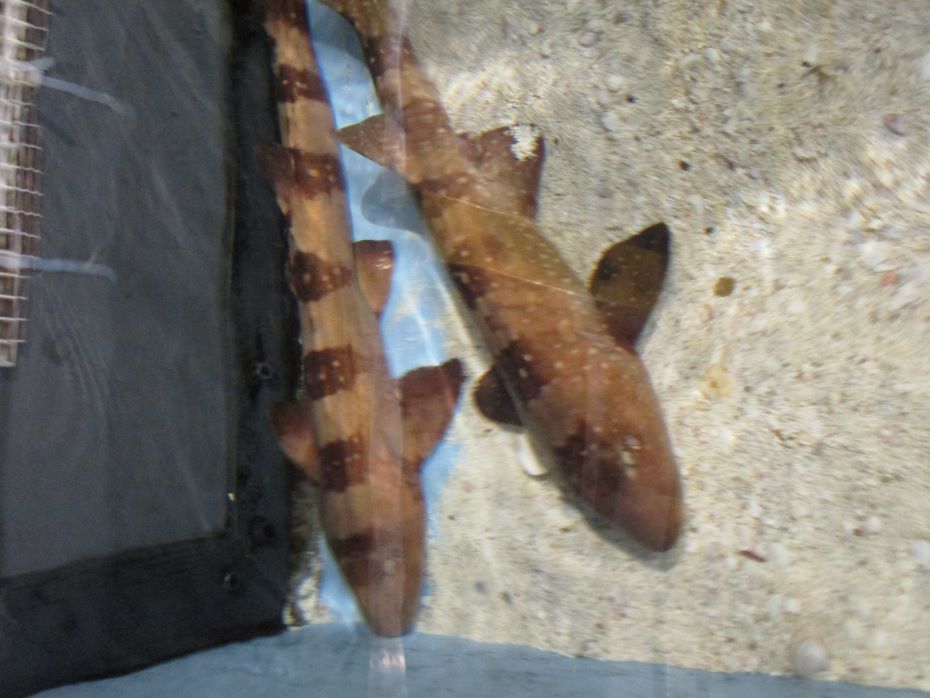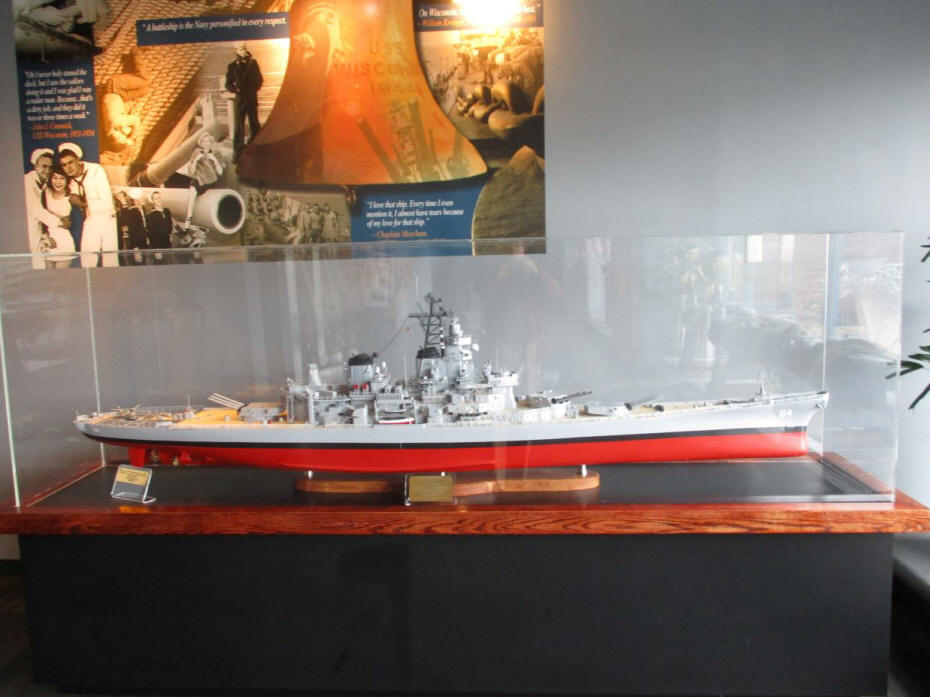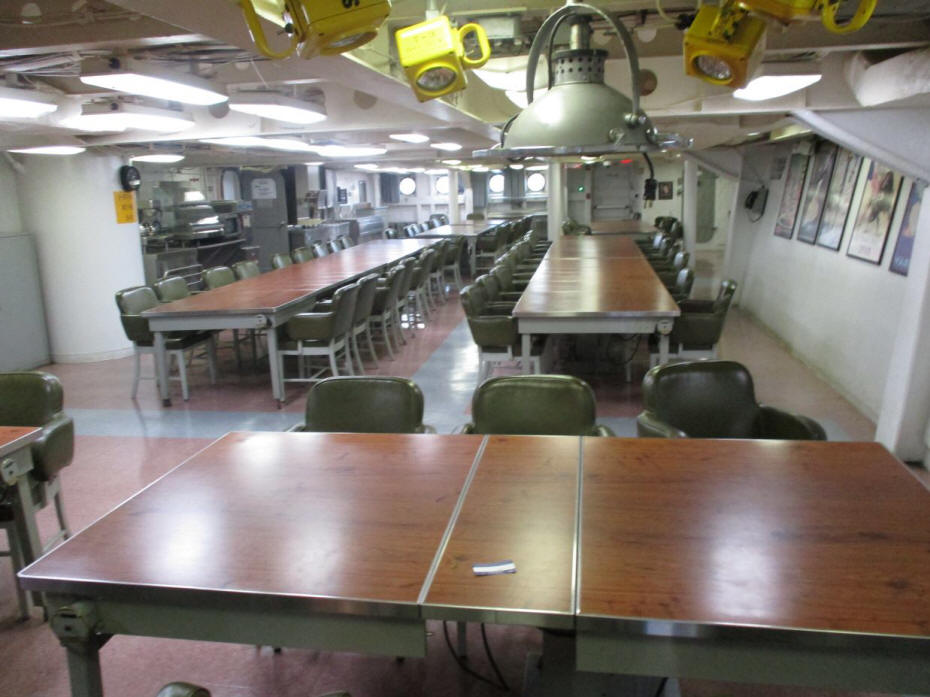|
Norfolk is the
second largest city in Virginia. Its history has
much to do with its location at the mouth of
Chesapeake Bay. It has Chesapeake Bay to the
north and the Elizabeth River to the west and
south, giving it a tremendous amount of
waterfront. All that water also means it
has an interesting naval and maritime history.
That history is on display at one of the city’s
best museums: the Nauticus, which includes the
Hampton Roads Naval Museum and the Battleship
Wisconsin.

Nauticus is a
maritime museum, plus an interactive science and
technology center that explores the naval,
economic, and nautical power of the sea. It has
Battleship Wisconsin-related exhibits, hands-on
exhibits, national-caliber traveling exhibits,
HD and 3D films on a giant screen, and even live
sharks. History buffs will find plenty of naval
history, especially related to Hampton Roads and
the Battleship Wisconsin.
 |
| As you’d
expect a huge anchor at the front of the
museum, plus a couple of travel mates.
|
The museum
includes many fascinating exhibits. An example
is “Secrets of the Deep” where you or your
family can step inside a submersible named the
Clelia and pretend to be the pilot or a NOAA
scientist. You control a nine-foot long robotic
arm to collect samples from the seafloor or
operate a remote-controlled camera to explore a
wreck site. While Nauticus is not an aquarium,
there is plenty of sea life on display.
Horseshoe Crab Cove provides a chance for kids
of all ages to admire and touch a horseshoe
crab. Shark Experience includes several types of
sharks.

| The submersible “Clelia,” part
of a very interactive exhibit.
|
 |
| Horseshoe Crab Cove, a chance
to touch a horseshoe crab. |
 |
|
Not all the sharks are huge at
Shark Experience. |
| |
 |
| There is plenty of sea life at
the museum.
|
The Battleship
Wisconsin is one of the four Iowa-class
battleships commissioned in 1939 and 1940 and
built during World War II (the others were the
Iowa, New Jersey, and Missouri). It was launched
two years after Pearl Harbor. These four were
the last battleships commissioned by the U.S.
Navy. The Wisconsin served in World War II, the
Korean War, and fired Tomahawk missiles during
the Persian Gulf War in 1991. “The Big Wisky”
was one of the largest American battleships ever
built. Its length is just over 887 feet. Its
main weapons were 16-inch guns, with 800-inch
length barrels, each
weighing 146 tons. It fired rounds weighing over
a ton, which could hit targets over 24 miles
away.
 |
| Battleship
ammunition for 16-inch guns; note the weight is
equal to a Volkswagen. |
 |
| What battleship
ammunition can do the side of a ship.
|
 |
| Naval history
exhibits include lots of material on the
battleship. |
 |
| As you’d expect,
there are lots of ship models at the museum.
|
The Wisconsin
provided support at the Battle of Iwo Jima,
sustained damage from a 155 mm round in the
Korean War, and was the last U.S. battleship to
fire its guns in combat. The City of Norfolk
took over ownership of the battleship in 2010,
creating today’s museum ship. Self-guided tours
are fun and easy, but there are more formal ones
like a guided command and control tour or a
“life in the engine room” guided tour.
 |
| Side view of the Wisconsin.
|
 |
| The guns of the Wisconsin. |
 |
| The Wisconsin had some serious
firepower. |
The battleship had
all the elements of a small city. From the basic
elements of places to eat and sleep, to complex
elements like dental and medical care,
libraries, and production facilities. Officers
had private or semi-private quarters (depending
upon rank). It takes hours to really gain
insights into how the ship must have operated
and how the sailors had to live.
 |
| Ship’s cafeteria. The sailors
ate well. |
 |
| Ships mess area. |
 |
| Berthing area for enlisted
men. |
 |
| Officer’s stateroom. |
The ship had a
general workshop, including a machine shop
containing large machines like lathes, mills,
drill presses, and saws. One important task was
to fabricate parts not carried onboard the ship.
The battleship even had a public affairs office.
Journalists, photographers, and public relations
junior line officers usually served as a public
affairs officer. Of course, the ship had a
chapel.
 |
| Machine shop |
.JPG) |
| Public affairs office. |
 |
| Ship’s chapel. |
Nauticus is
waterfront in Norfolk, walking distance to the
restaurants, and we walked to it from our hotel.
While a half day will do, there is easily a full
day’s adventure there. The “Big Wisky” BB64 Café
which offers fun, tasty, and creative spins on
classic American Fare as well as
culinary-inspired dishes from Asia and the South
Pacific Islands is in the Nauticus if you need
to eat lunch. That is a good reason to make a
day of it.
Author:
Thomas J. Straka is a forestry professor at
Clemson University. He has a keen interest in
history.
For additional
information:
Nauticus, Featuring
the Battleship Wisconsin website
https://nauticus.org/
Nauticus & USS
Battleship Wisconsin (State of Virginia)
https://www.dmme.virginia.gov/dmlr/AMLConference/NauticusBattleship.shtml
|







